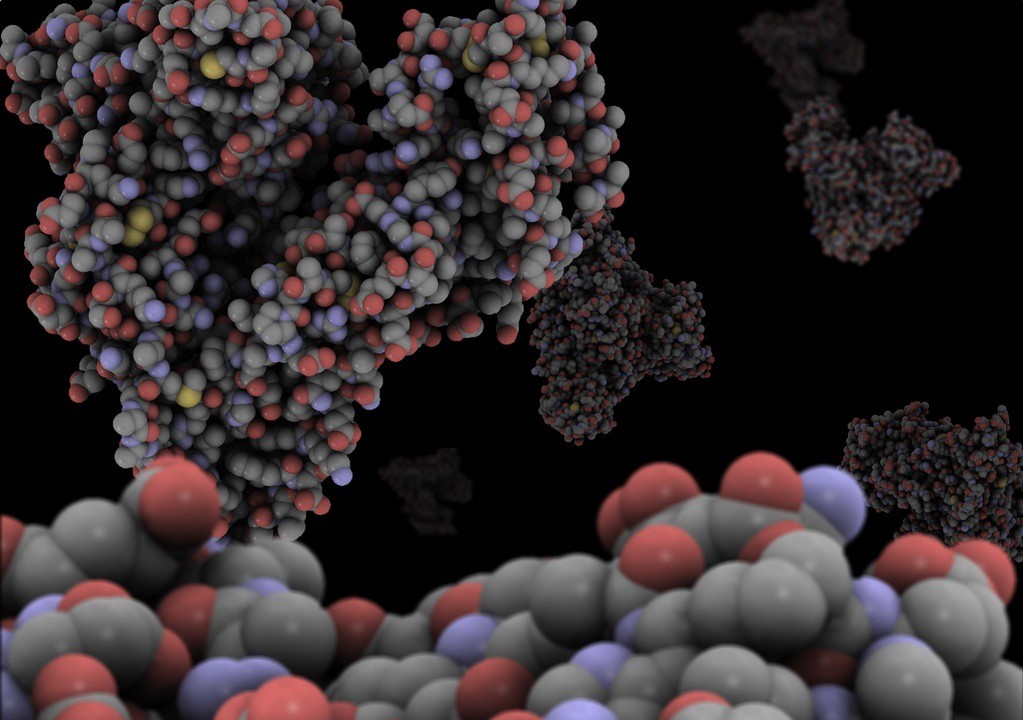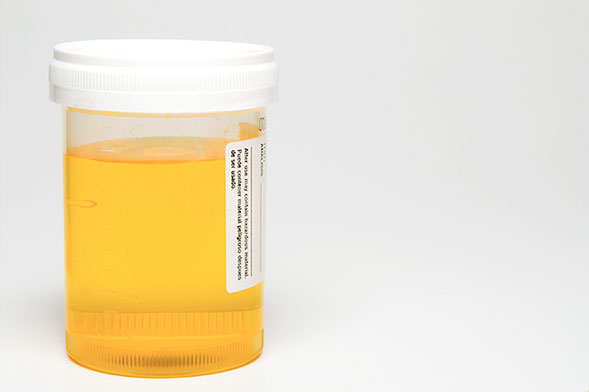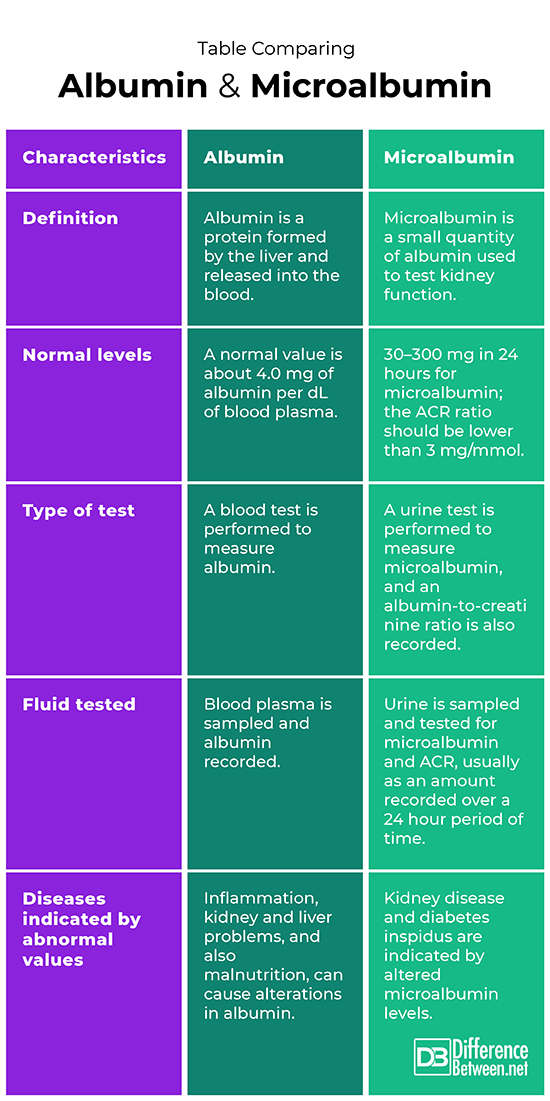Difference Between Albumin and Microalbumin
Albumin is one of the proteins in the body that is made in the liver and then released into the bloodstream. Microalbumin is a very small quantity of albumin that the kidney excretes.

What is Albumin
Definition:
Albumin is a type of globular protein that is manufactured by cells in the liver and released into the blood plasma.
Structure and properties:
Albumin protein makes up 66% of the protein in blood plasma, where it carries various substances and helps keep other blood proteins stable. Albumin is comprised of several alpha helices, which bond together to form a globular protein. The albumin has a molecular weight of about 66 kDa.
Formation and function:
Albumin is formed from preproalbumin in the liver cells called hepatocytes. Once the preproalbumin is modified in the Golgi apparatus to form albumin it is transported out of the liver cell and then released into the blood. It is found making up breast milk and provides some amino acids to an infant during breast feeding. Many substances can attach to albumin for transportation, including certain medications such as warfarin and methotrexate. Albumin also transports fatty acids, hormone secretions, and various ions through the bloodstream to where they are needed by cells of the body.
Diagnostic use:
Doctors can use albumin levels in the blood to help assess liver and kidney function and also to evaluate the nutritional status of patients. Ideally albumin should be at a concentration of 4.0 g/dL in plasma. Severe inflammation in the body from a number of conditions, including sepsis or burn injuries, can also cause a drop in the albumin level in blood.

What is Microalbumin?
Definition:
Microalbumin is albumin that is present in a very small amount, and is measured as part of a test of organ function.
Structure and properties:
Microalbumin has the same properties and functions as albumin since it is simply a very tiny amount of the protein albumin that is excreted by the kidney nephrons.
Formation and function:
The formation and function of microalbumin is the same as that of albumin and the presence of a certain concentration of microalbumin in urine can be used diagnostically in medicine to test for kidney function and to evaluate fluid balance.
Diagnostic use:
Healthy people do excrete a certain tiny amount of albumin in the urine. This is called microalbumin since it should be tiny amounts of about 30–300 mg of albumin excreted over a 24 hour period. The excretion of albumin by the kidneys is called microalbuminuria, where high values are suggestive of kidney damage, while low values of microalbumin likely indicate that the person has diabetes insipidus, a problem with the fluid balance in the body. An albumin-to-creatinine ratio, ACR, is also used diagnostically to assess a person’s health status, and the ratio should be lower than 3 mg/mmol in healthy individuals.
Difference between Albumin and Microalbumin?
Definition
Albumin is a type of protein that is formed by the liver and released into the blood. Microalbumin is a small quantity of albumin used to test kidney function.
Normal levels
The normal levels of albumin that a healthy person would have in the blood would be 4.0 mg/dL of blood plasma. The normal values of microalbumin a healthy individual would excrete in the urine are 30–300 mg in 24 hours for microalbumin; the ACR ratio would be lower than 3 mg/mmol.
Type of test
Albumin is measured by performing a blood test and evaluating the concentration per dL of blood. A urine test is performed to measure microalbumin, and an albumin-to-creatinine ratio is also recorded.
Fluid tested
Blood plasma is sampled and the quantity of albumin recorded. Microalbumin and the ACR ratio are both important and measured in the urine that is excreted over a 24 hour period.
Diseases indicated by abnormal values
Abnormal values of albumin in the blood plasma could show that a person may have Inflammation, kidney and liver problems, or even be suffering from some degree of malnutrition where they are not taking in enough protein. Abnormal microalbumin levels detected in the urine over a day can indicate that an individual likely has some problem or disease of the kidney, or has diabetes insipidus.
Table comparing Albumin and Microalbumin

Summary of Albumin Vs. Microalbumin
- Albumin and microalbumin are the same protein, but microalbumin is a tiny amount excreted in urine.
- Both albumin and microalbumin levels in the blood and urine, are important as tests of organ function.
- Albumin makes up much of the protein found in the plasma of the bloodstream where it binds to several molecules.
- Microalbumin and a microalbumin to creatinine ratio are both measured in urine as a diagnostic test that can indicate if a person has kidney disease or diabetes insipidus.
- Difference Between Rumination and Regurgitation - June 13, 2024
- Difference Between Pyelectasis and Hydronephrosis - June 4, 2024
- Difference Between Cellulitis and Erysipelas - June 1, 2024
Search DifferenceBetween.net :
Leave a Response
References :
[0]Britannica, The Editors of Encyclopaedia. "Albumin". Encyclopedia Britannica, 2019, https://www.britannica.com/science/albumin
[1]Guy, Mark, et al. "Diagnostic accuracy of the urinary albumin: creatinine ratio determined by the CLINITEK Microalbumin and DCA 2000+ for the rule-out of albuminuria in chronic kidney disease." Clinica Chimica Acta 399.1-2 (2009): 54-58.
[2]Moman, Rajat N., Nishant Gupta, and Matthew Varacallo. "Physiology, Albumin." StatPearls [Internet] (2020).
[3]Image credit: https://owqo93fpiuc4633lp1zthz57-wpengine.netdna-ssl.com/wp-content/uploads/sites/11/2018/12/urinesample_416805.jpg
[4]Image credit: https://live.staticflickr.com/5131/5477384350_f5abd3c50a_b.jpg
